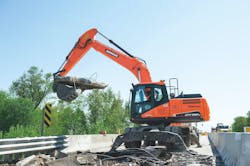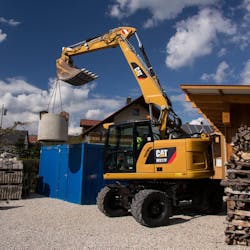Wheeled Excavator Choices Drive Acceptance
The relatively small wheeled excavator market in the U.S. is pinning its hopes for the near future on renewed infrastructure action and user recognition of versatility, and manufacturers are gearing up with more choices led by smaller, compact-radius models.
“Wheel excavators make up a small percentage of overall excavator sales in the United States and Canada, and wheel excavator sales have been down the past two years,” says Aaron Kleingartner, marketing manager, Doosan Construction Equipment. “There’s optimism about long-term investments in infrastructure, such as roads and bridges, and that may expand sales of wheel excavators.”
Cost of Ownership
Size class Average price Hourly rate* To 11.0 MTons $115,742 $47.51 11.2-13.0 Mtons $148,700 $67.97 13.1-15.0 MTons $202,105 $85.11 15.1-17.0 MTons $204,275 $85.30 17.1-20.0 MTons $261,563 $105.08 20.1 MTons & over $333.629 $120.13 Hourly rate represents the monthly ownership costs divided by 176, plus operating cost. Unit prices used in this calculation: diesel fuel at $2.53 per gallon; mechanic’s wage at $58.29 per hour; and money costs at 2.5 percent.
Source: EquipmentWatch.com
Matthew McLean, GPE product manager for Volvo, agrees. “In the coming years, the construction segment is expected to grow, and if any of the proposed infrastructure bills make their way through Congress, it could grow a lot,” he says. “From what we are seeing in the market, both building and heavy infrastructure are up from 2016, and year-to-date, we’re seeing the market for 2017 is slightly higher overall.”
U.S. fleets and municipalities still have a long way to go to match Europe’s zeal for wheeled excavators, but some OEMs see a possibility.
“The market for wheeled excavators in North America is small but growing,” says Caterpillar’s Vincent Migeotte, a product application specialist. “By contrast, the European market is about 10 times as large, which hints to the growth opportunities here. Within North America, the demand has traditionally been highest on the east coast, but we are seeing opportunities now in the rest of the U.S. and in Canada.”
Wheeled excavators have long been favored in Europe’s tightly constructed cities and narrow streets. The parallel here will have to be infrastructure work, where smaller, more mobile—and more versatile—machines are favored.
“It’s worth noting that wheel excavators are nearly four times more likely to be operated on an infrastructure project than a commercial construction project,” Kleingartner says. “On some large construction projects, including road and bridge construction, some companies prefer to leave a wheel excavator at the job site to assist with general excavating, non-production truck loading, and various other tasks. Wheel excavators are a versatile machine to use for general excavating, or as a small crane to off-load building and construction materials.”
Migeotte says that his company’s launch of short-radius machines (M315F, M317F) at Conexpo has created opportunities in applications where wheeled excavators hadn’t been considered before.
“One of the reasons for growth is that contractors are realizing that wheeled excavators can perform very well on dirt,” Migeotte says. “The mobility on a site without damaging the ground makes it an essential piece of equipment to boost efficiency and save costs. A common misperception is that wheeled excavators are only for paved surfaces.
“Another reason is that wheels generally have lower maintenance and operating costs than tracks, so in many cases the total O&O costs work in the wheeled excavator’s favor,” Migeotte says. “Design improvements in the last several years have resulted in very stable machines, and when using the stabilizers and variable-adjustment booms, the wheeled excavators actually can out lift their tracked counterparts or other wheeled-type machines. We firmly believe wheeled excavators have a great potential in North America and will grow rapidly in the coming years.”
McLean is also bullish on the future of the product category in the U.S. as far as trending toward European-type prominence. “There’s no reason why not, save for lack of exposure so far. In Europe, wheeled excavators are ubiquitous for utility work, often hauling around their own trailers, carrying the attachments and supplies required for the next job. When outfitted with brakes, you can haul up to an 8.5-ton trailer behind you,” he says.
“Lack of awareness and knowledge about the potential and performance of wheeled excavators are often the reasons contractors have never tried them,” Migeotte says.
“As contractors become more familiar with the benefits and versatility of wheeled excavators compared to backhoes, crawler excavators, and other equipment, popularity and machine usage will continue to prosper,” says Michael Fuller, product specialist for Hyundai. “Compared to Europe, market acceptance will take additional time to catch up, but we are headed in that direction.”
Hyundai has also bet on smaller wheeled excavators, with North American models in the 0- to 17-ton segment (R55W-9A, HW140) and the 17- to 20-metric-ton-class (HW180). “Similar in market size to the 20- to 25-ton models, the smaller 0- to 17-ton market has also shown promise,” Fuller says.
Volvo is another company that has gone compact. It introduced its smallest wheeled excavator at Conexpo, the 5-metric-ton EW60E.
Managers who choose to roll with wheeled excavators, whether small or large, should consider a number of factors before buying.
“Maneuverability is an important consideration,” says Doosan’s Kleingartner. “If contractors need a machine that can travel across finished concrete and asphalt without leaving marks or tearing up the surface, wheel excavators are a popular choice. Wheel-excavator owners can reduce or eliminate the need to lay down plywood or mats when moving a crawler excavator across an established surface. When it’s hot, it doesn’t take much for a crawler excavator to damage an asphalt surface, making a wheel excavator a smarter choice.”
“Consider if the machine should be designed with just outriggers or outriggers and a dozer blade,” Kleingartner says. “Dozer blades provide a means for wheel-excavator operators to perform clean-up type work on a job site. For example, if a contractor configures a wheel excavator with a smooth-edge bucket, the operator can use it with the machine’s dozer blade to perform clean-up tasks and minimize the need for other machines to do this type of work. Dozer blades can also be used for some backfilling, just like other smaller crawler excavators.
“Then, contractors can choose between a single or dual—also known as a variable angle—boom configuration,” Kleingartner says. “One of the benefits of the dual-angle boom is the ability to work closer to the machine. The operator can shorten the working radius, which helps when working in a tight area or during clean-up tasks. Also, when operators are driving on a road, they can pull the main boom further back, providing the operator with better visibility to the right-hand side.”
Managers should weigh tire choices, as well. Although pneumatic tires are usually standard on wheeled excavators, solid tires are an option depending on the application. “Solid tires may be a good option for contractors who are working in an area where there may be broken concrete or asphalt, such as a demolition project, to protect the tires from potential damage and unnecessary downtime,” Kleingartner says.
Also, consider the overall versatility. “A growing type of application is one where the full use of the hydraulic power is required,” Caterpillar’s Migeotte says. “This can be anything from attaching a mower head or brush cutter to clean up vegetation alongside a road to using a snowblower to clean railways, with a modified chassis. Quarries use wheeled excavators with a hammer to break up oversized material.
“Grapples and other attachments are used for cleaning up after storms or other natural disasters,” Migeotte says. “And the addition of an ex factory trailer option allows the operator to be self-sufficient and carrying attachments or material to perform various tasks throughout the workday.”
Finally, Migeotte points out the possibilities of managers using multiple attachments with the same carrier.
“Another factor when considering the machine is the number of hydro-mechanical tools that will be used. With standard high- and medium-pressure lines and a quick coupler circuit, wheeled excavators become extremely versatile,” he says. “[Our] machines are equipped with a standard tool control system that allows them to store up to 10 different types of work tools with the proper pressure and flow for easy changes between attachments.”

